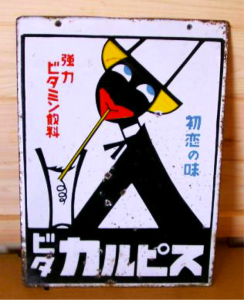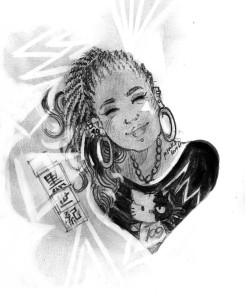Let’s take it back to Japan circa 2014 and talk about black appreciation vs. appropriation…
The whir of Tokyo’s streets spins with hurried black and white suits, fluorescent billboards and the flashier street fashion of the motley youth. Here many people seem to have their thing: The transcultural hipster slumps his way across town as if he isn’t wearing the hottest brands. The bubbly gyaru gals twirl their blond hair as they head to the tanning salon. The gothic Lolita stands solemn on the train all lady-like in her Victorian frills.
Neophila breathes through the fabric of each fashion trend. You could almost tell who a person was, where they hung out and maybe what they had for breakfast. Tokyo is kind of like a high school sitcom where the world only makes sense in archetypes—or so I was told.
Before I moved to Japan to become an English teacher, one of my friends told me about the notorious B-Stylers that hang out in the hip hop clubs. “B-Style” stands for Black Style. It is a culture that venerates the video vixens of American hip-hop and worships OG’s like 50 Cent and Jay Z. My friend then showed me a Japanese tv broadcast about a woman named Hina.
During her second year of primary school, Hina’s hair became frizzy and suddenly she started to pay attention to black culture in the media. She found B-Style and fell in love. Perhaps she was attracted to difference because her hair couldn’t conform.
“It’s a tribute to [black] fashion, music and dance,” said Hina. “Part of B-Style is that you do not look Japanese.” She worked in a shop called Baby Shoop and went tanning once a week.
I moved to Japan and kept Hina at the back of my mind. B-Style just seemed like this silly anomaly that I’d never see. I had spent months teaching English to young kids and toddlers and enjoyed the simplicity of living in the countryside. However during my spring vacation, I decided to wander the streets of Tokyo and get a taste of the modern rush. Lo and behold, I found someone just like Hina speeding through Tokyo on a silent train car. She stood in front of me holding the rail with one hand, texting with the other.
Black for life. Confidence glittered off of her jeans. Black for life. Pride bubbled beneath her moles. Dazzling and flamboyant, her cool nature was oddly refreshing. Suddenly I too felt studded and imperial. Black for life!
For most of my teenaged days, I fought so hard to be the opposite of Ms. Hina. I wanted to be the Cosmo girl I would see in the magazines: you know, modestly thin with pin-straight hair wearing a choker (as was customary in the early 2000s). Now here’s a girl who is dying for yaki braids and a booty? As the train swayed, she cradled me in a side-glance.
If you are patient enough to read comments from YouTube trolls, black Americans are quick to call Hina and Co. flat-out racist minstrels, but I think many people fail to consider the cultural context.
First, you can blame (or maybe brag about) the power of the international hip-hop market. Hip-hop media propagates catchy tracks and trendy fashions that many non-black people want to emulate or adopt. Here we run into issues of cultural appropriation and the proliferation of the “stereotypical black person.” As the common phrase goes, “everybody wants to be black until the cops come,” but many of these Japanese people don’t have the cops to run from.
It was my impression that there was no distinct history of racial slavery that would develop anti-black racism. In other words, if Hina dropped the n-word bumbling along to Trinidad James in the club because it’s the only word she understood, it didn’t imply that she truly knew what the word meant. Should I be mad? Does she have to know?
Maybe I should tell her.
But how do I encapsulate all of the years of lashing, fire hoses, lynching and sit-ins … Where do I begin? Hina doesn’t know Rosa Parks so is it fair for me to demand that she understands the American Civil War back and forth when I couldn’t even tell you about the uprisings during the Edo period?
It turns out I can’t let Hina completely off the hook.
You can trace anti-black racism back to Commodore Perry in the mid-19th Century. In 1854, Commodore Perry opened up American relations with Japan and he treated the Japanese negotiators to a blackface minstrel show. They were called Perry’s “Ethiopian minstrels” and they traveled all over Japan (“Excluded Presence” 28).

Calpis drink poster. Photo credit: Things We Lost at Dusk
Anti-black sentiments and stereotypical images have been imported for years. Anthropologist John G. Russell has done extensive study on “blackness” in Japan. In his essay, “Race and Reflexivity: The Black Other in Contemporary Japanese Mass Culture” Russell traces the iconographic presence of black caricatures from anime, to dolls, to statues and commercials. Black people were portrayed as aggressive and uncivilized but at the same time childish and wide-eyed. Take for example Dakko-chan or Calpis Negro. Dakko-chan was a popular doll that exhibited the typical large lips and black skin of African caricatures. Calpis Negro was a minstrel trademark designed by German artist Otto Dünkelsbuhler in 1923 (“Race and Reflexivity” 11).
In “Excluded Presence: Shoguns, Minstrels, Bodyguards and Japan’s Encounters with the Black Other,” Russell claims that all of these images and stereotypes were the little exposure that Japanese people had to black people and this reinforced the idea of white supremacy:
The majority of Japanese were in no position to witness the situation of blacks for themselves. Their isolation insured that they would remain dependent on information about blacks from external sources [the Americans and Europeans who] shared a system of institutionalized slavery and an unmitigated contempt for blacks based on an ideology of white supremacy, an ideology backed by a technological and military might that seemed to justify it. (31)
However he also adds that it is much more complicated than that: “Japanese attitudes towards blacks have never been static, monolithic or universally negative” (“Excluded Presence” 39). From my experience, there seems to be an odd appreciation of black culture.
Minstrel shows still exist in Japan as a form of acceptable entertainment. After a large outcry from expatriates, Fuji TV had to cancel the March 7th broadcast of Rats and Stars—a well-known blackface doo-wop group in Japan. No doubt they are talented and highly professional. The band is more of a tribute than a charade, but everything is perverted by their choice of makeup. There’s a sort of innocence behind the mask.
B-Style is the trendy parallel to Rats and Stars. It too lacks cultural awareness, but there is also the added element of escapism. Russell explains:
With … the rise of the counterculture and the influx of black popular music and culture, disaffected Japanese youth came to see the African American as a counter to the values of the Japanese establishment and the black Other was adopted as a symbol of defiance, forbidden fruit, and their own alienation from the Japanese mainstream. (“Race and Reflexivity” 21)
Hina’s mom is not bothered by her daughter’s piercings or flashy dress. She’s not worried that her daughter might become the next Nicki Minaj because one day she will take the costume off and trade it for another–perhaps a nice blazer with a sharp skirt. One day she will no longer be a rebel and become a “responsible” Japanese citizen.
When “blackness” equals rebellion we have a problem.
But, that girl on the train—the girl that looked like Hina—to me she was a breath of fresh air. Forget trends, forget cultural appropriation and forget phases. This was someone who wanted to be black when I spent so many of my years trying to be white. She left the train and I sat muddled with my grey thoughts. Still I embraced the softness of the elusive cloud.
This piece is dedicated to the little people who accepted me. Fully, undoubtedly and lovingly.

